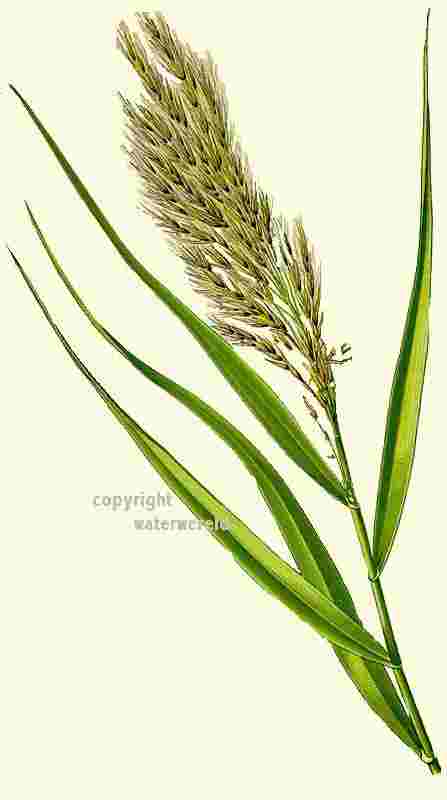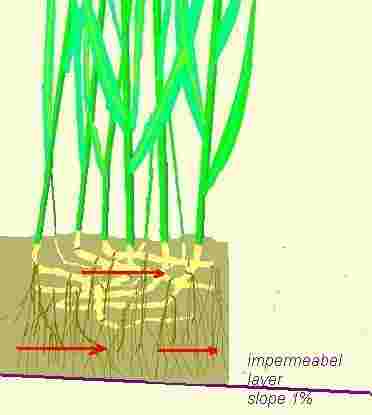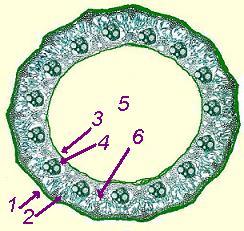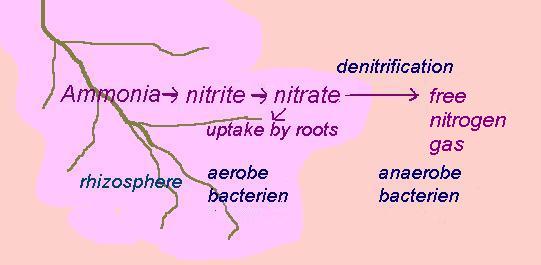

The vertical reed bed system.
In a reed bed with vertically flow the water first passes the
rhizome zone with sand as substrate and then the root zone with
grain as substrate. A vertical Reed bed system works more efficientely
then a horizontal reed bed system. But requiers more management, the reed
beds are often operated for a few days then rested, so several beds are needed
and a distribution system.

The horizontal reed flow system uses a long reedbed, where the liquid
slowly flows horizontally through. The length of the reed bed is about
100 meter.
.
|
Reed
A tall waterplant up to 4 meter high grass. These plants produces rhizomes and have roots
that are fixed deeply in the mud. The leaves are long and flat and about 4cm wide.
Reed grows on the edges of ponds and lakes, and with there long stems they can tolerate
large fluctuations in the waterlevel.
Reed is strong
Reed can grow in brakkish or heavely polluted waters, even crude oil. It can
withstand periods of dryness.Its roots grow in mud without oxygen.
These plants are invasive as they grow faster than the other plants.
Reed is a helofyt
Helofyts are those plants that live on the border of a pond or lake , have long stems,
and prefer a low waterlevel. The most abundant is the common reed or Phragmites Australiensis, but
cattails can be abundant too. Helofyts give shelter for a lot of pond animals, like
waterinsects and snails and leeches, some use the hollow stem as a hiding place
in wintertime. The stem of a helofyt is hollow and the plant use this central space
to transport oxygen to the roots. Helofyt all have rhizomes.

Schematic cross section through a reed stem,
1 epidermis, the skin of the stem.
2 subepidermal sclerenchym
3 thin layer
4 vascular bundle
5 central space , transport of oxygen
6 parenchym
Rhizomes and rhizospheres
Rhizomes are thick , up to 2cm thick roots, that are used for reproduction.
They grow horizontally through the underground. The rhizomes are hollow as they
transport oxygen to the roots. The oxygen is then leaked to the surrounding mud
producing an oxygen rich area, called rhizosphere.
Here aerobic bacteria oxygenize ammonia and phosfate, the key for removing these
polluting agents.
Nitrates

Ammonia is oxygenized by aerobic baceria and forms nitrite and nitrates.
A lot of oxygen is need for this transformation, and these aerobic bacteria lives
near the roots and rhizomes, called the rhizosphere. Then denitrification takes place,
producing free nitrogen gas. This proces does not need the use of oxygen. A small part
part of the nitrates are used by the reed itself.
slowing down of the ammonia removal
At the end of the summer the removal of nitrates lowers.
This is partly because the reed itself doesn't need the nitrate for itself anymore.
When growing mature the reed transports less oxigen to the substrate and so lowers
the cleaning capacity of the reedbed.
Phosphates
 the phospate is reduced in three ways:
the phospate is reduced in three ways:
1 By fixation of phoshate to the substrate. This proces can be enhanced by using iron, or
iron sulphate as an addition to the substrate.(Fe3+ + PO43- --> FePO4 }
2 By binding phosphate to the bacteria and plantdetrusis
3 By uptake of phosphate through the roots. The reed use the phosfate for its own use.
This can be enhanced by removing the dead reed part at the end of the summer.
| |

